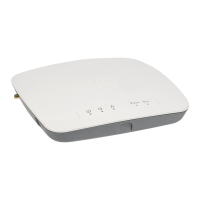Advanced Configuration
91
ProSAFE Dual-Band Wireless AC Access Point WAC720 WAC730
f. Specify the settings as explained in the following table:
Setting Description
Profile Definition
Profile Name Enter a profile name that is easy to remember. The default name is
NETGEAR-WDS-1.
Remote MAC Address Enter the MAC address of the remote wireless access point (the MAC address
of
AP2 on LAN Segment 1 in Figure 5 on page 90).
Authentication Settings
Network
Authentication and
Data Encryption
From the Network Authentication menu, select Open System, WP
A-PSK, or
WPA2-PSK. Your selection determines the options that the Data Encryption
menu provides, and whether the WPA Passphrase (Network Key) field
displays.
WPA-PSK TKIP (T
emporal Key Integrity Protocol) is the standard
encryption method used with WPA-PSK and the only
selection possible from the Data Encryption menu.
In the WP
A Passphrase (Network Key) field, enter a
passphrase. The passphrase length needs to be between
8 and 63 characters (inclusive).
WPA2-PSK AES (Advanced Encryption Standard) is the standard
encryption method used with WP
A2-PSK and the only
selection possible from the Data Encryption menu.
In the WP
A Passphrase (Network Key) field, enter a
passphrase. The passphrase length needs to be between
8 and 63 characters (inclusive).
Note: We recommend WPA2-PSK authentication with AES
encryption if you want to use the 11n rates and speed.
g. Click Apply to save your security profile settings. The Bridging page displays again.
h. If the correct profile name and security option are displayed in the table, select the
check box in the Enable column.
i. Click Apply on the Bridging page to save your point-to-point bridge settings.
2. Configure a second wireless access point (AP2) on LAN Segment 2 (see Figure 5 on
page 90) in point-to-point bridge mode.
AP1 needs to have AP2’s MAC address in its Remote MAC Address field, and AP2
needs to have
AP1’s MAC address in its Remote MAC Address field.
3. Verify the following settings for both wireless access points:
• Both wireless access points are configured to operate in the same LAN network
address range as the LAN devices.
• Both wireless access points use the same channel, authentication mode, and security
settings.
4. Verify connectivity across the LAN 1 and LAN 2.

